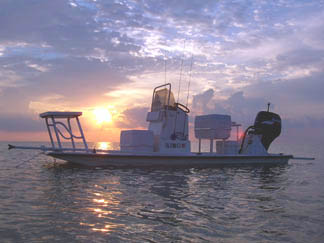
The Saltwater Magazine for Gulf Coast Fishing!

Me Gusta mi Chiquita!
by Kyle Tomek
- (I Like
my Chiquita!)
- Blaze backwaters in search of tailing reds, pole across a desolate flat in mere inches, navigate trophy trout country in waters never accessed by anything other than airboats; the Flatlander Chiquita enables these opportunities to become achievable. Measuring out at 14 and a half feet long, the skinny water beast has assisted me in fishing waters ranging from East Matagorda, West Matagorda Bay, Espiritu Santo, to the lower lagoon of Port Mansfield. With over 200 hours and almost a year in, I feel like I have yet to experience everything this vessel has to offer.

My Chiquita's History
I picked the rig up used at TranSport in Palacios, Texas. Being three years old, the hull was still in great shape. My only worry was how well it did in rough water. The first test run was to run dead-on into 30 mph winds at Port Mansfield, Texas. The Chiquita exceeded my expectations. I stayed dry. Waves crashed the hull; it felt rough; but nothing I thought I would expect from a scooter.
Don't get me wrong, all scooters are likely to be rough, but this one proved everyone wrong when facing the struggles of turbulent h2o.
Advantages to Scooters
Scooter boats are perfect for those trips out with only one or two people. Why burn all the gas for all of the extra room of a large bay boat if you're only taking one or two people fishing? By choosing a scooter, one saves gas and reach locales that all other bay boats couldn't think about getting to.
Another plus to owning a Chiquita is how safe these things actually are. For instance, when navigating through shallow areas new to you. While running, I jack up the motor on my jackplate at a level where the bottom of the skeg doesn't even show underneath the boat. The uprising tunnel blasts water to the motor and exterminates the risk of losing a lower unit. This is very good for long flats with unknown depths. The only time I worry of sticking my Chiquita is if mud is spraying in the back, or if I don't see any more water. It's just stupid to actually know how shallow you can navigate.
I have plenty of spots in West Matagorda Bay that can only be accessed with a super shallow running boat like my Chiquita. I would say over half of my best days for redfish have been in locations that I had to run in less then six inches to get to.
I once reached a back cove that held over eight schools of redfish. While running tight to the shoreline evading a strong south wind, I noticed birds hovering inches above the water. Moving a little closer revealed that baitfish scrambling across the surface. Seeing this sort of situation reminded me of popcorn being popped as shrimp and baitfish bounced off the surface of the water. I poled up to this school of redfish as my buddies stood on the platform in front casting and hooking up with bronze line peelers on every cast. Eight more schools became evident as we landed the reds. The schools were difficult to find, it was easy to hear the popping and explosions the reds created. An afternoon like this would not have been possible if it wasn't for my Chiquita.
Escaping to bluewater isn't always impossible with a scooter as well. When the surf allows, I have been known to run my Chiquita to the first rigs from Matagorda. I have also motored from Matagorda all the way to the POC jetties when searching for specks in the surf.
Rigging
Keep it simple when rigging. Due to the storage being quite limited, it's best to carry only what you need. In the front locker, I store my lifejackets, drift sock, and throw cushion. The anchor fits snugly in the crate I keep in front of my fish box. My dry box stores rain gear, extra reels, line, and tackle I need. One tool that will most likely be used if running your Chiquita in skinny water is a few pieces of pvc. If you run shallow water enough, you will eventually get hung up. A few pieces of pvc can roll the Chiquita easily back into navigable waters. I have even used my push pole on a few occasions to slide me across salt grass when I missed turns.
After speaking with Forest at Marine Service, the home of Flatlander, he informed me of some updates on the Chiquita.
"As soon as we get a Chiquita in the building stages, it gets sold right away," says Forest.
A larger console, more rod holders, increased storage in front, a fiberglass leaning post with storage, and an area underneath that is sealed for dry storage are all additions to the Flatlander hull.
Powering this rig is usually done with a 50 horsepower motor. I have a Suzuki 4 Stroke 50 I purchased from Busha Boat Works in Bay City that has done awesome. I have had zero problems to date and the gas mileage couldn't be better. I have made a round trip from Matagorda to Port O'Connor and burned less than 10 gallons of gas.
For an economical approach to taking the road less traveled, choose a Flatlander Chiquita scooter.
www.flatlanderboats.com - phone: 361-552-4975
www.bushaboatworks.com